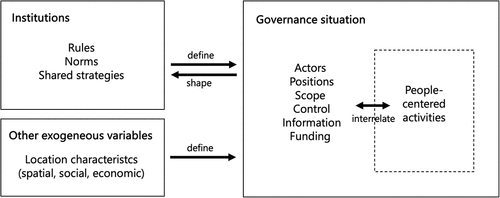Figures & data
Figure 1. Institutional landscape of people-centered planning practice: analytical framework inspired by the IAD framework (Polski & Ostrom, Citation1999; Ostrom, Citation2005).

Figure 2. Location of the urban development projects within their cities and countries (images are without scale) [Source: Author].
![Figure 2. Location of the urban development projects within their cities and countries (images are without scale) [Source: Author].](/cms/asset/f8f6c2c9-93c6-4049-b280-c6e0aa98984b/cppr_a_2312341_f0002_oc.jpg)
Table 1. Basic information about the two UDPs in which the people-centered practices took place.
Figure 4. Activities during H22 exhibition as part of dialogue approach in DrottningH [Source: Author].
![Figure 4. Activities during H22 exhibition as part of dialogue approach in DrottningH [Source: Author].](/cms/asset/85c8c53b-a3b9-494c-b2f5-55c27f7bb006/cppr_a_2312341_f0004_oc.jpg)
Table 2. Main people-centered activities in Seestadt and DrottningH.
Table 3. Governance situations of the two people-centered activities in the two cases.
Table 4. (a) Variables affecting actors, positions, and control in Seestadt and DrottningH.
Table 4. (b) Variables explaining scope, control, and information in Seestadt and DrottningH.
Table 4. (c) Variables affecting actors, positions, and control in Seestadt and DrottningH.

![Figure 3. Office of neighborhood management in Aspern Seestadt [Source: Author].](/cms/asset/fc58e186-7bad-4c62-9c2f-958d68059b9b/cppr_a_2312341_f0003_oc.jpg)